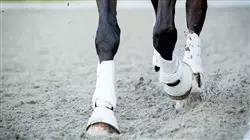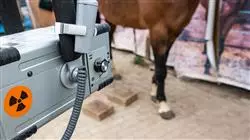University certificate
The world's largest faculty of veterinary medicine”
Introduction to the Program
You will learn to master and develop in depth diagnostic imaging techniques and other complementary diagnostic methods in the field”

The examination, diagnosis and treatment of pathologies that require surgical intervention are among the main occupations in the equine field clinic, so it is important for the veterinarians to update their knowledge of the processes of immediate intervention, so that they can enhance their knowledge of the different needs and areas that require surgery.
Given the needs of equines, veterinarians must know the most important affectations, so this program will help them to identify the most vulnerable parts of the horses, those that are exposed to suffer pathologies that require surgical procedures.
To this extent, this program becomes an inexhaustible source of veterinary information, in which professionals will be able to find different diagnostic, treatment and intervention techniques. Recovery, rehabilitation therapies and postoperative procedures will also be discussed.
Good perioperative management and the use of an adequate surgical technique will make it possible to preserve the patients' life and, in certain cases, their return to sports practice at the previous level, since appropriate treatment will make it possible for the affected anatomical region to maintain normal functionality and for the esthetic results to be optimal.
Students of the Postgraduate diploma in Field Surgical Disorders in Adult Horses will have access to first level education, thanks to the incorporation of a series of exclusive Masterclasses given by an international renowned expert in the equine field. These masterclasses will address various equine pathologies and will allow students to gain in-depth knowledge and apply advanced therapeutic techniques and strategies.
You will have access to exclusive Masterclasses in the educational program, which will allow you to acquire specialized knowledge from the best international experts"
This Postgraduate diploma in Field Surgical Disorders in Adult Horses contains the most complete and up-to-date scientific program on the market. The most important features include:
- The latest technology in online teaching software
- A highly visual teaching system, supported by graphic and schematic contents that are easy to assimilate and understand
- Practical cases presented by practicing experts
- State-of-the-art interactive video systems
- Teaching supported by telepractice
- Continuous updating and recycling systems
- Autonomous learning: full compatibility with other occupations
- Practical exercises for self-assessment and learning verification
- Support groups and educational synergies: questions to the expert, debate and knowledge forums
- Communication with the teacher and individual reflection work
- Content that is accessible from any fixed or portable device with an Internet connection
- Supplementary documentation databases are permanently available, even after finishing the course
A comprehensive preparatory program that will allow you to acquire the most advanced knowledge in all fields of intervention of the equine veterinarian"
The program’s teaching staff includes professionals from the field who contribute their work experience to this educational program, as well as renowned specialists from leading societies and prestigious universities.
The multimedia content, developed with the latest educational technology, will provide the professional with situated and contextual learning, i.e., a simulated environment that will provide immersive education programmed to prepare for real situations.
This program is designed around Problem-Based Learning, whereby the professional must try to solve the different professional practice situations that arise during the course. For this purpose, the students will be assisted by an innovative interactive video system created by renowned and experienced experts.
With the experience of working professionals and the analysis of real cases of success, in a high-impact preparatory approach"

With a methodological design based on proven teaching techniques, this innovative course will take you through different teaching approaches to allow you to learn in a dynamic and effective way"
Why study at TECH?
TECH is the world’s largest online university. With an impressive catalog of more than 14,000 university programs available in 11 languages, it is positioned as a leader in employability, with a 99% job placement rate. In addition, it relies on an enormous faculty of more than 6,000 professors of the highest international renown.

Study at the world's largest online university and guarantee your professional success. The future starts at TECH”
The world’s best online university according to FORBES
The prestigious Forbes magazine, specialized in business and finance, has highlighted TECH as “the world's best online university” This is what they have recently stated in an article in their digital edition in which they echo the success story of this institution, “thanks to the academic offer it provides, the selection of its teaching staff, and an innovative learning method aimed at educating the professionals of the future”
A revolutionary study method, a cutting-edge faculty and a practical focus: the key to TECH's success.
The most complete study plans on the university scene
TECH offers the most complete study plans on the university scene, with syllabuses that cover fundamental concepts and, at the same time, the main scientific advances in their specific scientific areas. In addition, these programs are continuously being updated to guarantee students the academic vanguard and the most in-demand professional skills. In this way, the university's qualifications provide its graduates with a significant advantage to propel their careers to success.
TECH offers the most comprehensive and intensive study plans on the current university scene.
A world-class teaching staff
TECH's teaching staff is made up of more than 6,000 professors with the highest international recognition. Professors, researchers and top executives of multinational companies, including Isaiah Covington, performance coach of the Boston Celtics; Magda Romanska, principal investigator at Harvard MetaLAB; Ignacio Wistumba, chairman of the department of translational molecular pathology at MD Anderson Cancer Center; and D.W. Pine, creative director of TIME magazine, among others.
Internationally renowned experts, specialized in different branches of Health, Technology, Communication and Business, form part of the TECH faculty.
A unique learning method
TECH is the first university to use Relearning in all its programs. It is the best online learning methodology, accredited with international teaching quality certifications, provided by prestigious educational agencies. In addition, this disruptive educational model is complemented with the “Case Method”, thereby setting up a unique online teaching strategy. Innovative teaching resources are also implemented, including detailed videos, infographics and interactive summaries.
TECH combines Relearning and the Case Method in all its university programs to guarantee excellent theoretical and practical learning, studying whenever and wherever you want.
The world's largest online university
TECH is the world’s largest online university. We are the largest educational institution, with the best and widest online educational catalog, one hundred percent online and covering the vast majority of areas of knowledge. We offer a large selection of our own degrees and accredited online undergraduate and postgraduate degrees. In total, more than 14,000 university degrees, in eleven different languages, make us the largest educational largest in the world.
TECH has the world's most extensive catalog of academic and official programs, available in more than 11 languages.
Google Premier Partner
The American technology giant has awarded TECH the Google Google Premier Partner badge. This award, which is only available to 3% of the world's companies, highlights the efficient, flexible and tailored experience that this university provides to students. The recognition as a Google Premier Partner not only accredits the maximum rigor, performance and investment in TECH's digital infrastructures, but also places this university as one of the world's leading technology companies.
Google has positioned TECH in the top 3% of the world's most important technology companies by awarding it its Google Premier Partner badge.
The official online university of the NBA
TECH is the official online university of the NBA. Thanks to our agreement with the biggest league in basketball, we offer our students exclusive university programs, as well as a wide variety of educational resources focused on the business of the league and other areas of the sports industry. Each program is made up of a uniquely designed syllabus and features exceptional guest hosts: professionals with a distinguished sports background who will offer their expertise on the most relevant topics.
TECH has been selected by the NBA, the world's top basketball league, as its official online university.
The top-rated university by its students
Students have positioned TECH as the world's top-rated university on the main review websites, with a highest rating of 4.9 out of 5, obtained from more than 1,000 reviews. These results consolidate TECH as the benchmark university institution at an international level, reflecting the excellence and positive impact of its educational model.” reflecting the excellence and positive impact of its educational model.”
TECH is the world’s top-rated university by its students.
Leaders in employability
TECH has managed to become the leading university in employability. 99% of its students obtain jobs in the academic field they have studied, within one year of completing any of the university's programs. A similar number achieve immediate career enhancement. All this thanks to a study methodology that bases its effectiveness on the acquisition of practical skills, which are absolutely necessary for professional development.
99% of TECH graduates find a job within a year of completing their studies.
Postgraduate Diploma in Field Surgical Disorders in Adult Horses
This program is a complete review of all the latest developments in the diagnosis and treatment of surgical disorders in adult horses. That is why the student will be able to delve into the examination, diagnosis and treatment of conditions that require procedures and interventions of primary need. On the other hand, it is important that the professional can identify the new recent updates, so that an initial diagnosis can be made beforehand and subsequently the intervention can be successful. This is a high-quality program, which will propel the professional to the highest levels of excellence. This specialization offers participants the opportunity to acquire the necessary skills and knowledge to be able to diagnose, treat and prevent surgical disorders in adult horses. In addition, students will also learn about field surgery techniques in emergency situations. The program is aimed at professionals in equine veterinary medicine, as well as general veterinarians who wish to specialize in this area. It is also an excellent option for students who wish to focus their career in the area of equine surgery.
Study from the comfort of your home
TECH offers the opportunity to study fromhome or from anywhere in the world, students only need an Internet connection and that's it. At the end of the Postgraduate Diploma, participants will have acquired a set of practical skills and theoretical knowledge that will allow them to perform as specialists in diagnosis, treatment and prevention of field surgical disorders in adult horses. In conclusion, the Postgraduate Diploma in Field Surgical Disorders in Adult Horses is a high-level educational program that offers students specialized and practical expertise in the area of equine veterinary medicine, specifically in the surgical area. Knowledge and skills that will allow them to perform efficiently and competently in the labor market







